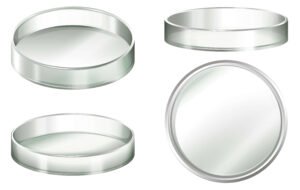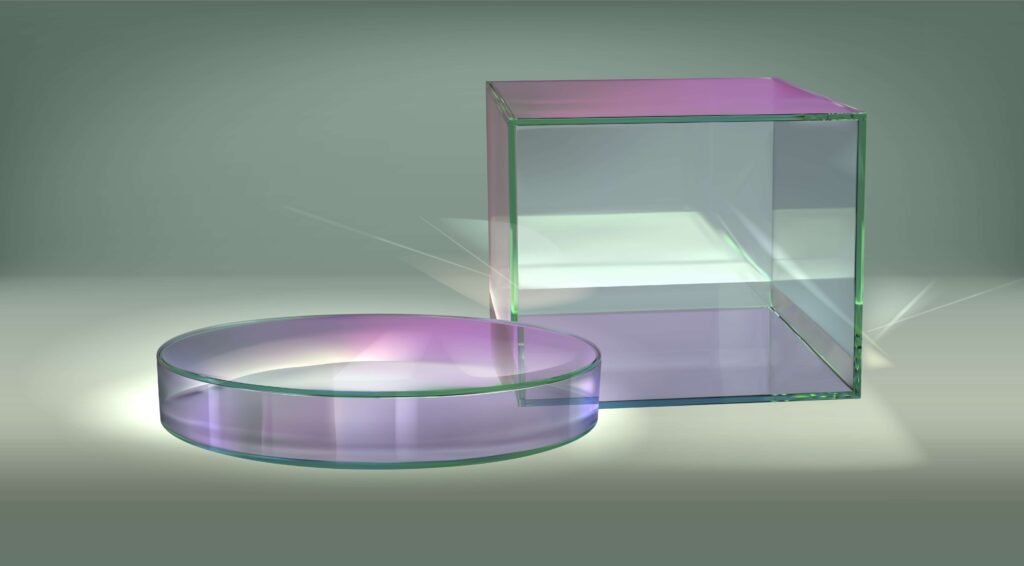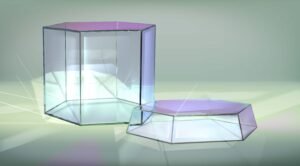Borosilicate window glass is a special kind of glass used in high-precision optical tools. It is not the same as the normal glass used in homes. This type of glass can handle very high heat, pressure, and chemical use. It stays clear and strong even in rough working conditions.
In my years working with optical materials, I have seen how borosilicate glass helps engineers build safe, strong, and reliable equipment. It is trusted in laboratories, cameras, telescopes, and even in space missions.
In this article, I’ll explain what borosilicate window glass is, how it is made, what makes it better than regular glass, and how it helps in the optical industry.
What is Borosilicate Window Glass?
Borosilicate window glass is made from silica (SiO₂) and boron trioxide (B₂O₃). These two materials give it very special properties. The boron makes the glass strong and helps it resist breaking when the temperature changes.
This glass can handle heat up to about 500°C and still stay stable. Because of this, it is used in microscopes, industrial viewing windows, laser systems, and scientific instruments.
It is also non-toxic, clear, and safe for use in medical and laboratory environments. That is why many industries prefer it over regular window glass.
Composition and Material Science
Borosilicate window glass is made by mixing silica, boron trioxide, alumina, and sometimes small amounts of sodium oxide and potassium oxide.
Here’s how each element works:
-
Silica (SiO₂): Forms the main glass structure and keeps it hard.
-
Boron trioxide (B₂O₃): Makes the glass resist heat and chemical changes.
-
Alumina (Al₂O₃): Improves strength and reduces scratches.
-
Sodium & Potassium oxides: Help in melting and shaping the glass.
These ingredients make borosilicate glass more stable and durable than other types. In optical work, this means the glass doesn’t expand, bend, or blur the image, even in hot or cold conditions.
Key Optical and Physical Properties
Borosilicate window glass has many special properties that make it perfect for optical use:
-
High Light Transmission: It allows light to pass through clearly without distortion.
-
Low Thermal Expansion: It doesn’t crack or change shape with heat.
-
High Strength: It can resist scratches and mechanical stress.
-
Chemical Resistance: It doesn’t react with water, acids, or solvents.
-
Temperature Stability: Works safely in high and low temperatures.
In real optical testing, borosilicate glass stays clear even after repeated laser exposure or cleaning. This makes it a long-lasting choice for optical windows, camera lenses, and protective covers.
Making borosilicate window glass requires careful control. The process starts with melting silica, boron oxide, and other materials at very high temperatures (around 1500°C). The melted mix is cooled slowly to remove internal stress — a process called annealing.
After this, the glass is cut, polished, and coated depending on its final use. For optical purposes, anti-reflective or UV coatings are added to improve clarity.
Each piece goes through quality checks for thickness, flatness, and optical clarity to ensure it meets strict standards used in labs and optical devices.
Borosilicate vs Other Optical Glass Types
Borosilicate window glass stands out when compared to other glasses:
| Type of Glass | Heat Resistance | Optical Clarity | Cost | Common Uses |
|---|---|---|---|---|
| Soda Lime Glass | Low | Medium | Low | Windows, bottles |
| Tempered Glass | Medium | Medium | Medium | Safety glass |
| Fused Silica | Very High | Excellent | High | Lasers, optics |
| Borosilicate Glass | High | Excellent | Medium | Optics, Labs, Industry |
Borosilicate glass offers a balance — high optical clarity, great strength, and lower cost than fused silica. That’s why it’s used in many precision optical systems.
Industrial & Optical Applications
Borosilicate window glass is used in many fields because of its strength and clarity:
-
Optical Instruments: For lenses, microscopes, and telescopes.
-
Laser Systems: Used as laser protection windows.
-
Industrial Viewing Panels: Allow safe viewing in chemical or heat zones.
-
Scientific Equipment: Beakers, flasks, and lab windows.
-
Aerospace Optics: For windows that face extreme temperatures.
I’ve seen borosilicate windows used in laser testing labs and industrial furnaces — they stay clear even after years of use.
Benefits of Using Borosilicate Window Glass

-
Strong and long-lasting
-
Handles high heat without cracking
-
Stays clear with high light transmission
-
Safe, non-toxic, and chemical-resistant
-
Cost-effective for high-precision optical tools
These benefits make it the top choice for companies building scientific and optical products.
Limitations and Maintenance Factors
While borosilicate window glass is strong, it still needs care. It can break under sudden shocks or if dropped on a hard surface.
Maintenance tips:
-
Clean with soft cloth and alcohol-based solution.
-
Avoid rough handling or strong mechanical force.
-
Use protective coatings when working with lasers.
With proper care, borosilicate glass can last for many years without losing clarity.
Customization and Coating Options
Manufacturers can make borosilicate window glass in different sizes, thicknesses, and coatings depending on the need.
Common coating types include:
-
Anti-Reflective (AR) Coating: Reduces light reflection and glare.
-
UV Coating: Protects from ultraviolet rays.
-
Hydrophobic Coating: Keeps the surface free from water or dust.
In precision optics, custom coatings help control how much light passes through or reflects off the glass surface.
Borosilicate Window Glass in the Future of Optics
Borosilicate glass is becoming more important in AR/VR systems, laser protection, and imaging optics. As new optical devices become smaller and more powerful, this glass provides the right balance of clarity, heat resistance, and strength.
In the coming years, borosilicate materials will continue to be used in space optics, medical imaging, and energy research, thanks to their reliable performance.
Choosing a Reliable Borosilicate Window Glass Supplier

When selecting a supplier, look for:
-
Proven experience in the optical industry
-
ISO or CE quality certifications
-
Ability to offer custom coatings and precision cutting
-
Clear product data sheets (refractive index, tolerance, etc.)
Always work with suppliers who understand optical standards and testing requirements. This ensures your project gets materials that perform as expected.
Is borosilicate glass suitable for all optical wavelengths?
Borosilicate glass is ideal for visible and near-infrared wavelengths, offering excellent clarity and light transmission. For specialized applications involving UV or far-infrared wavelengths, other materials may be preferred, but borosilicate provides reliable performance for most general optical needs.
Can borosilicate window glass handle laser exposure?
Borosilicate glass can safely accommodate laser exposure when properly coated and cooled. Its robust thermal resistance helps prevent damage, and specialized anti-reflective coatings further improve its suitability for use with lasers in scientific and technical settings.
How is borosilicate glass different from regular glass?
Unlike ordinary glass, which can crack or shatter under heat, borosilicate glass remains strong and stable even at high temperatures. Its unique composition makes it highly resistant to thermal shock, chemical corrosion, and mechanical stress, setting it apart for demanding applications.
Is borosilicate glass safe for labs and medical instruments?
Absolutely. Borosilicate glass is non-toxic and highly resistant to most chemicals, making it a trusted material for laboratory environments and medical devices. Its durability and safety profile ensure reliable performance in sterile and sensitive conditions.
Borosilicate window glass is one of the most trusted materials in the optical world. It stays clear, strong, and safe even in tough environments. Whether used in lasers, microscopes, or aerospace windows, it delivers reliable performance for years.
Thanks to its balance of strength, heat resistance, and clarity, it remains the clear choice for modern optical applications. If you want quality and precision, borosilicate window glass will never disappoint.


